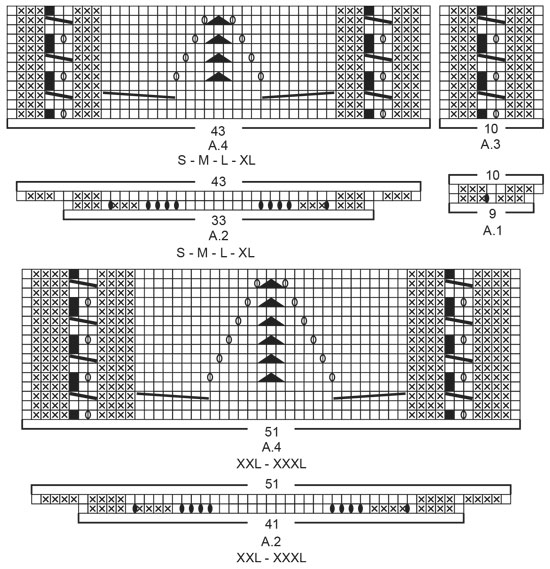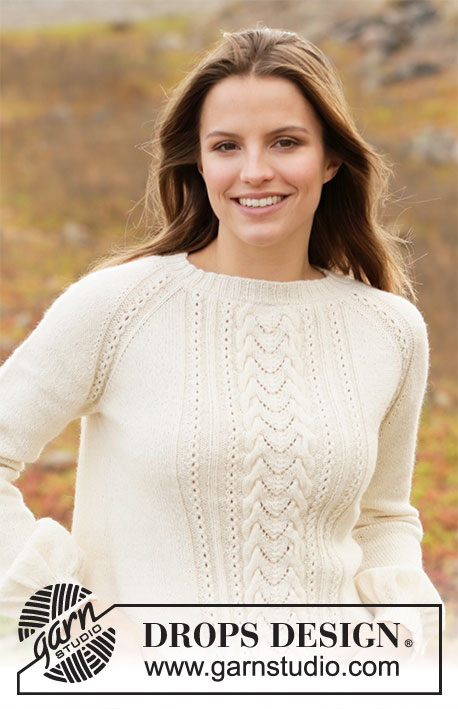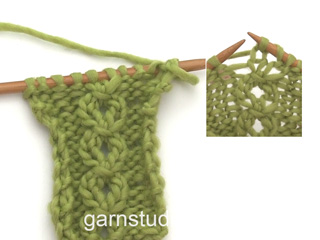Signs of Spring |
||||||||||||||||||||||||||||
 |
 |
|||||||||||||||||||||||||||
Knitted jumper in DROPS BabyMerino. The piece is worked top down with raglan, cables and lace pattern. Sizes S - XXXL.
DROPS 213-4 |
||||||||||||||||||||||||||||
|
------------------------------------------------------- EXPLANATIONS FOR THE PATTERN: ------------------------------------------------------- INCREASE TIP-1 (evenly spaced): To work out how to increase evenly, count the total number of stitches on the needle (e.g. 116 stitches) and divide by the number of increases to be made (e.g. 36) = 3.2. In this example, increase by making 1 yarn over after approx. each 3rd stitch. On the next round work the yarn overs twisted to avoid holes. PATTERN: See diagrams A.1 to A.4. Choose diagram for your size (applies to A.2 and A.4). RAGLAN: Increase 1 stitch on each side of the pattern-band along each raglan-line, i.e. on each side of A.3 (= 8 stitches increased on the round). Increase 1 stitch by making 1 yarn over. On the next round knit the yarn overs twisted to avoid holes. Then work the new stitches in stocking stitch. INCREASE TIP-2 (for sides of body and mid under sleeves): Work until there are 2 stitches left before the marker thread, make 1 yarn over, knit 4 (marker thread sits between these 4 stitches) make 1 yarn over (= 2 stitches increased at each marker thread). On the next round knit the yarn overs twisted to avoid holes. Then work the new stitches in stocking stitch. DECREASE TIP (for mid under sleeves): Work until there are 3 stitches left before the marker thread, knit 2 together, knit 2 (marker thread sits between these 2 stitches), slip 1 stitch as if to knit, knit 1 and pass the slipped stitch over the knitted stitch (= 2 stitches decreased). CASTING-OFF TIP: To avoid the cast-off edge being tight you can cast off with a larger size needle. If the edge is still tight, make 1 yarn over after approx. each 4th stitch at the same time as casting off and the yarn overs are cast off as normal stitches. ------------------------------------------------------- START THE PIECE HERE: ------------------------------------------------------- JUMPER – SHORT OVERVIEW OF THE PIECE: The neck and yoke are worked in the round with circular needle, top down. The yoke is divided for body and sleeves and the body continued in the round with circular needle. The sleeves are worked in the round with short circular needle/double pointed needles, top down. NECK: Cast on 116-120-124-128-136-140 stitches with circular needle size 2.5 mm and Baby Merino. Knit 1 round. Then work rib in the round (= knit 2 / purl 2) for 3 cm. Knit 1 round where you increase 36-40-40-36-40-40 stitches evenly spaced – read INCREASE TIP-1 = 152-160-164-164-176-180 stitches. Knit 1 round without increasing and insert 1 marker in this round. Then work the yoke as described below. The yoke is measured from the marker. REMEMBER THE KNITTING TENSION! YOKE: Change to circular needle size 3 mm and work the first round as follows (from the left back raglan-line when the garment is worn): Work A.1 (= 9 stitches), then 53-57-59-59-65-67 stitches in stocking stitch (= back piece), A.1 (= 9 stitches), 5 stitches in stocking stitch (= top of sleeve), A.1 (= 9 stitches), 1-3-4-4-3-4 stitches in stocking stitch, A.1 (= 9 stitches), A.2 (= 33-33-33-33-41-41 stitches mid front), A.1 (= 9 stitches), 1-3-4-4-3-4 stitches in stocking stitch, A.1 (= 9 stitches) and finish with 5 stitches in stocking stitch on top of sleeve. There are 168-176-180-180-192-196 stitches on the needle. Work the next round in the same way following the diagrams. On the next round work as described below, AT THE SAME TIME increase to RAGLAN – read description above: Work A.3 (= 10 stitches), increase 1 stitch to raglan, work 53-57-59-59-65-67 stitches in stocking stitch (= back piece) and increase 1 stitch to raglan, work A.3 (= 10 stitches), increase 1 stitch to raglan, 5 stitches in stocking stitch (= top of sleeve), increase 1 stitch to raglan, A.3 (= 10 stitches), increase 1 stitch to raglan, 1-3-4-4-3-4 stitches in stocking stitch, A.3 (= 10 stitches), A.4 (= 43-43-43-43-51-51 stitches mid-front), A.3 (= 10 stitches), 1-3-4-4-3-4 stitches in stocking stitch, increase 1 stitch to raglan, work A.3 (= 10 stitches), increase 1 stitch to raglan, 5 stitches in stocking stitch (= top of sleeve) and increase 1 stitch to raglan (= 8 stitches increased on the round). Continue this pattern and increase to raglan every 2nd round a total of 13-16-19-24-28-31 times (including the round described above) and then every 4th round a total of 8-8-8-8-7-7 times. After the last increase to raglan there are 336-368-396-436-472-500 stitches on the needle. Continue the same pattern but without further increases until the yoke measures 19-21-23-25-27-29 cm from the marker on the neck. Cut the strand. Now divide the yoke for the body and sleeves on the next round as follows: Place the first 10-10-11-10-9-7 stitches on 1 thread for the sleeve (without working these stitches), work stocking stitch over the next 95-105-111-123-137-149 stitches (= back piece), place the next 67-73-81-89-93-95 stitches on 1 thread for the sleeve, cast on 10-10-12-12-14-16 new stitches on the needle (= in side), continue with stocking stitch and pattern over the next 107-117-123-135-149-161 stitches (= front piece), place the remaining 57-63-70-79-84-88 stitches on the same thread as the first part of the sleeve at the beginning of the round and cast on 10-10-12-12-14-16 new stitches under the sleeve (= in side). BODY: = 222-242-258-282-314-342 stitches. Insert 1 marker thread on each side of the body in the middle of the 10-10-12-12-14-16 stitches cast on under each sleeve. Allow the threads to follow your work onwards; they will be used when increasing in the sides. Work stocking stitch over the back piece as far as the first marker thread. The round now starts here. Continue with stocking stitch in the round and A.3 and A.4 over the middle 63-63-63-63-71-71 stitches mid front as before. When the piece measures 3 cm from the division, increase 1 stitch on each side of both marker threads – read INCREASE TIP-2 (= 4 stitches increased). Increase like this every 5 cm a total of 5 times on each side of the body = 242-262-278-302-334-362 stitches. Continue working until the body measures 27 cm from the division (there is 5 cm left to finished length; try the jumper on and continue to desired length). On the next round decrease 12 stitches over the cables in A.3 and A.4 (decrease 4 stitches over each of the 2 large cables and 1 stitch over each of the small cables by knitting 2 together) = 230-250-266-290-322-350 stitches left on the needle. Knit 1 round over all stitches and increase 70-74-78-86-98-106 stitches evenly spaced = 300-324-344-376-420-456 stitches. Change to circular needle size 2.5 mm and work rib (= knit 2 / purl 2) for 5 cm. Loosely cast off with knit over knit and purl over purl – read CASTING-OFF TIP! The jumper measures approx. 54-56-58-60-62-64 cm from the shoulder down. SLEEVES: Place the 67-73-81-89-93-95 stitches from the thread on the one side of the piece on double pointed needles or short circular needle size 3 mm and knit up 1 stitch in each of the 10-10-12-12-14-16 stitches cast on under the sleeve = 77-83-93-101-107-111 stitches. Insert a marker thread in the middle of the 10-10-12-12-14-16 stitches under the sleeve. Allow the thread to follow your work onwards; it will be used when decreasing under the sleeve. Start the round at the marker thread and work stocking stitch in the round. When the piece measures 2 cm from the division decrease 2 stitches mid under the sleeve – read DECREASE TIP. Decrease like this 1½-1½.1½-1½-1½-2 cm a total of 7-7-8-8-7-5 times = 63-69-77-85-93-101 stitches. When the piece measures 16 cm from the division, increase 2 stitches mid under the sleeve – read INCREASE TIP-2. Increase like this every 1 cm a total of 21-18-18-14-14-14 times = 105-105-113-113-121-129 stitches. Continue working until the sleeve measures 41-39-38-36-35-33 cm from the division (there is 5 cm left to finished length; try the jumper on and continue to desired length). NOTE: Shorter measurements in larger sizes due to wider neck and longer yoke. Knit 1 round where you decrease 1 stitch = 104-104-112-112-120-128 stitches. On the next round knit all stitches together 2 and 2 = 52-52-56-56-60-64 stitches. Change to double pointed needles size 2.5 mm and work rib (= knit 2 / purl 2) for 5 cm. Loosely cast off with knit over knit and purl over purl. The sleeve measures approx. 46-44-43-41-40-38 cm from the division. Work the other sleeve in the same way. |
||||||||||||||||||||||||||||
Diagram explanations |
||||||||||||||||||||||||||||
|
||||||||||||||||||||||||||||

|
||||||||||||||||||||||||||||

|
||||||||||||||||||||||||||||
|
Have you made this or any other of our designs? Tag your pictures in social media with #dropsdesign so we can see them! Do you need help with this pattern?You'll find tutorial videos, a Comments/Questions area and more by visiting the pattern on garnstudio.com. © 1982-2024 DROPS Design A/S. We reserve all rights. This document, including all its sub-sections, has copyrights. Read more about what you can do with our patterns at the bottom of each pattern on our site. |
||||||||||||||||||||||||||||












































































Comments / Questions (53)
A1 andre omgang der hvor 3 vrange starter en foran forrige omgang. Når jeg så skal strikke 2 rette + den som inneholder kastet fra forrige omgang, så blir det vel 2 rette og 3 vrange. Disse tre vrange blir så til høyre og ikke rett over fra forrige omgang. Stemmer dette?
01.04.2022 - 21:18DROPS Design answered:
Hei Marit. Når du strikker 2. pinne av diagrammet blir det 1 rett, 3 vrange, 3 rette (den siste retten strikkes vridd rett), 3 vrange, 1 rett. De 3 siste vrang maskene forskyves mot venstre. mvh DROPS Design
04.04.2022 - 14:57Varför står det vä bakre raglan - stickningen går vidare med bak stycket . Borde stå hö bakre raglan ?? Skriv tydligare att A1 A2 görs klart innan man börjar med A3 varvet .
08.02.2022 - 09:54DROPS Design answered:
Hej Ulla, du starter på din venstre side når tøjet er på, strikker ryggen, så højre ærme, forstykke og sidst venstre ærme. Begge pinde i A.1 og A.2 er beskrevet i opskriften. God fornøjelse!
09.02.2022 - 12:30Bonjour, je suis au niveau des cotés et j'ai une question sur la forme en trapeze. il est dit de faire une augmentation de 5*4 puis diminution de 12m puis à nouveau augmentation avant les cotes. Est-ce que cela donne un résultat un peu bouffant et large ? sur les photos cela n'est pas visible. J'ai peur que le pull soit large. Et si je ne fais pas les 5*4 augmentations quel rendu aurra-t-il ? Merci
26.01.2022 - 18:40DROPS Design answered:
Bonjour Mme Rivière, les augmentations sur les côtés (5 x 4 mailles tous les 5 cm) vont donner la largeur indiquée dans le schéma; lorsque vous diminuez 12 mailles dans les torsades, c'est pour conserver la bonne largeur de l'ouvrage (il faut davantage de mailles pour les torsades que pour le jersey), puis vous augmentez des mailles juste avant de tricoter les côtes, pour éviter qu'elles ne resserrent le bas du pull. Si vous ne souhaitez pas la forme trapèze, vous pouvez ne pas faire les augmentations des côtés si vous le souhaitez, ajustez le nombre d'augmentations avant les côtes pour avoir un multiple de 4. Bon tricot!
27.01.2022 - 08:36Is the raglan just before A3 every round? So raglan (over) stitch, and than immediately A3 (pattern) every round? Extra raglan, A3 ,extra raglan, or else??
13.01.2022 - 11:54DROPS Design answered:
Dear Mrs Otten, yes correct you increase 1 stitch on each side of each A.3, as described under YOKE, ie the increase before the first A.3 on the round will be worked at the end of the round. After ou have increased 13 to 31 times (see size) on every other round, increase on every 4th round (8 or 7 times - see size). Happy knitting!
13.01.2022 - 13:23Maglione sofficissimo, ho fatto la taglia L e ho acquistato un gomitolo in più per farlo un po' più lungo all'altezza dei fianchi, sono molto soddisfatta!
01.01.2022 - 22:06Hej. Jeg forstår ikke, at der i A3 er angivet, at man har lukket en maske af tidligere - så vidt jeg kan se, har man da ikke lukket masker af endnu. Hvordan skal jeg strikke dette? Venligst Signe
03.12.2021 - 21:36DROPS Design answered:
Hei Signe. Første gang du strikker A.3, strikkes diagrammet over A.1. Siste omgang i A.1 går over 10 masker og da vil det stemme med A.3. Når du strikker 3. omgang av A.3 feller du 1 maske (skrå strek over 3 masker), da vil du ha 1 maske mindre pr gang du strikker diagrammet og på neste omgang er den masken som er felt (ingen masker) marker med en sort firkant. mvh DROPS Design
07.12.2021 - 10:02A minta leírása a magyar fordításban csapnivaló!
02.09.2021 - 19:13I sådana fall kanske ni bör förtydliga det i mönstret, för jag hade lite panik ett tag över de 8 extra maskorna
27.04.2021 - 14:36Jag räknade mina maskor efter ökningarna i raglan och hade rätt antal, men precis när jag skulle dela upp arbetet i fram-och bakstycke (efter 21 cm, storlek M) hade jag plötsligt 8 maskor för mycket. Jag tror att det beror på att jag delade upp arbetet efter omslagen i de 8 smala mönstren, men innan minskningarna som görs genom att lyfta en maska över två andra. Kan det stämma?
27.04.2021 - 13:52Nydelig genser - finnes denne (eller nesten lik) oppskriften med start nede og strikkes opp?
10.04.2021 - 16:33DROPS Design answered:
Hei Gunnbjørg, Hvis du skriver 'genser nedenfra opp' i søkeboksen, får du alle slike oppskrifter. Håper du finner en du liker og god fornøyelse!
12.04.2021 - 07:00